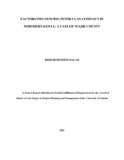| dc.description.abstract | Inter-clan conflicts have at best prevented people from developing their bountiful human and
natural potential. Communities in Northern Kenya have co-existed peacefully since their
migrations and settlement. They have traded, intermarried and shared many social festivals.
However, the same communities have experienced unending conflicts spanning two or more
decades despite existence of institutions that ought to have solved the conflicts. The main
objective of this study was to establish the factors influencing inter-clan conflict in Northern
Kenya, with a focus on Wajir County. The study specifically sought; to assess the influence of
scarcity of resources on inter-clan conflict in Northern Kenya; to establish the influence of
dominance and politics on inter-clan conflict in Northern Kenya; to examine the influence of
cultural values on inter-clan conflict in Northern Kenya; and to establish the influence of
administrative boundaries on inter-clan conflict in Northern Kenya. This study employed a
descriptive survey research design. The study population constituted of 400 randomly selected
community members from 6 sub-counties of Wajir County, 12 community leaders elders of
Wajir County, and one senior County Security Official from the County Government of Wajir.
The study relied on data collected through a questionnaire structured to meet the objectives of
the study. Responses were tabulated, coded and processed by use of a computer Statistical
Package for Social Science (SPSS) version 20.0 programme to analyze the data. Quantitative
information was summarized into frequencies, percentages and graphs using. Qualitative
information in the interview guide were transcribed and reported in narrative reports. The study
found that there exists a positive association between; scarcity of resources and inter-clan
conflict in Wajir County, dominance and politics and inter-clan conflict in Wajir County Cultural
Values and inter-clan conflict in Wajir County, and administrative boundaries and inter-clan
conflict in Wajir County. This positive association suggests that when one factor increases, interclan
conflict in Northern Kenya increases. The study therefore concludes that Human scarcity of
resources, dominance and politics, cultural Values and administrative boundaries influence interclan
conflict in Northern Kenya. The study recommends there is need youth empowerment
through job creation; curbing feasibility study and environmental impact assessment
establishment of future administrative units and sinking of boreholes; economic empowerment
for the youth to curb manipulation by the politicians and by extension radicalization;
enforcement of traditional system of compensation, 100 camels for a man killed and 50 for a
woman and this needs to be done with binding agreement with involvement of political class
such as governors, senators, members of parliament, women representatives, members of county
assembly, chiefs, elders and religious leaders; and prosecution of perpetrators of inter-clan
conflicts because currently compensation is done by clansmen. | en_US |

